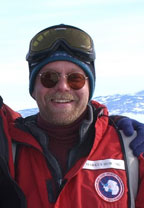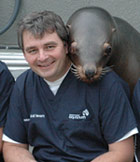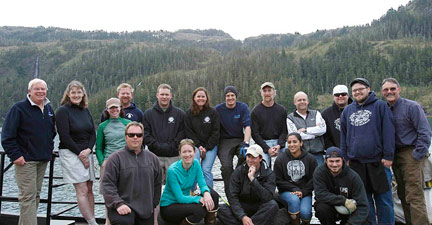Meet the LHX Team
 Markus started out scrubbing seal tanks and ended up with a career. As a college student Markus took a job as seal tank cleaner at the Scripps Institution of Oceanography. His interest in seals and sea lions deepened when he was offered an opportunity to travel to Antarctica to study seals. Markus often has project ideas during his fieldwork. The idea for the Life History Transmitter Project came up while he was doing aerial surveys for Steller sea lions along the Aleutian Islands in 1998. Markus developed the concept of the Life History Transmitter and the core software the tags use to determine the host animal’s state . Working with Roger Hill of Wildlife Computers, Markus built the first few Life History Transmitters in his former lab at Texas A&M University at Galveston.
Once Wildlife Computers began the production of a larger number of tags, Markus then focused on coordinating the overall LHX project. Markus next took a faculty position at Oregon State University as a pinniped ecologist for the Marine Mammal Institute. From there, he studied seals and sea lions using telemetry in Oregon, Alaska, and as far away as the Antarctic.
In 2015 Markus moved to the Alaska SeaLife Center to take on the role of Science Director. He stepped down from this administrative position to once again focus on his studies in marine biology as a Senior Research Scientist at the ASLC in 2019.
In 2020 he founded the Alaska Marine Science Association, LLC (dba Wildlife Technology Frontiers) in Seward, Alaska, where he is continuing his research and expanding into exciting new projects involving sleeper sharks.
Markus started out scrubbing seal tanks and ended up with a career. As a college student Markus took a job as seal tank cleaner at the Scripps Institution of Oceanography. His interest in seals and sea lions deepened when he was offered an opportunity to travel to Antarctica to study seals. Markus often has project ideas during his fieldwork. The idea for the Life History Transmitter Project came up while he was doing aerial surveys for Steller sea lions along the Aleutian Islands in 1998. Markus developed the concept of the Life History Transmitter and the core software the tags use to determine the host animal’s state . Working with Roger Hill of Wildlife Computers, Markus built the first few Life History Transmitters in his former lab at Texas A&M University at Galveston.
Once Wildlife Computers began the production of a larger number of tags, Markus then focused on coordinating the overall LHX project. Markus next took a faculty position at Oregon State University as a pinniped ecologist for the Marine Mammal Institute. From there, he studied seals and sea lions using telemetry in Oregon, Alaska, and as far away as the Antarctic.
In 2015 Markus moved to the Alaska SeaLife Center to take on the role of Science Director. He stepped down from this administrative position to once again focus on his studies in marine biology as a Senior Research Scientist at the ASLC in 2019.
In 2020 he founded the Alaska Marine Science Association, LLC (dba Wildlife Technology Frontiers) in Seward, Alaska, where he is continuing his research and expanding into exciting new projects involving sleeper sharks.
 Jo-Ann's experience with seals and sea lions has come about by being in the right place at the right time, not just once but three times. Even though she had grand plans to study the physiology of salamanders, her project fell through. Undeterred, she got up the nerve to call up a new professor who unexpectedly took her on to work on a project with seals. That was more than 15 years ago, and she has been working with seals and sea lions ever since. During a short time in Texas, she met Markus Horning and once again was in the right place at the right time. Markus was working on a tag that was to be used in Steller sea lions in Alaska. Her skills in health assessments were essential to the LHX project so he asked her to join the project. Shortly afterwards, Jo-Ann took a Research Faculty position with the University of Alaska Fairbanks at the Alaska SeaLife Center. This facility has served as the home base for the implant project since the first Steller sea lion was implanted in 2005. The team has worked so well together that they also work jointly on projects in the Antarctic. In 2015, Jo-Ann moved from Seward to Anchorage to take on a new role with the North Pacific Research Board (North Pacific Research Board)
Jo-Ann's experience with seals and sea lions has come about by being in the right place at the right time, not just once but three times. Even though she had grand plans to study the physiology of salamanders, her project fell through. Undeterred, she got up the nerve to call up a new professor who unexpectedly took her on to work on a project with seals. That was more than 15 years ago, and she has been working with seals and sea lions ever since. During a short time in Texas, she met Markus Horning and once again was in the right place at the right time. Markus was working on a tag that was to be used in Steller sea lions in Alaska. Her skills in health assessments were essential to the LHX project so he asked her to join the project. Shortly afterwards, Jo-Ann took a Research Faculty position with the University of Alaska Fairbanks at the Alaska SeaLife Center. This facility has served as the home base for the implant project since the first Steller sea lion was implanted in 2005. The team has worked so well together that they also work jointly on projects in the Antarctic. In 2015, Jo-Ann moved from Seward to Anchorage to take on a new role with the North Pacific Research Board (North Pacific Research Board)
 Marty was the Staff Veterinarian for nine years at The Marine Mammal Center in Sausalito, California when he met Markus Horning who was beginning his tag testing for the LHX project. His specialized skills in the medical management of pinnipeds made him an invaluable member of the team. Marty developed safe anesthetic protocols and improved surgical techniques for use in Steller sea lions. He performs the surgery to implant the Life History Transmitter tag into Steller sea lions and helps manage their medical care during the tag implanting procedure. Marty has been Staff Veterinarian at the Vancouver Aquarium since 2006. (http://www.vanaqua.org/mmr/crew/veterinarian)
Marty was the Staff Veterinarian for nine years at The Marine Mammal Center in Sausalito, California when he met Markus Horning who was beginning his tag testing for the LHX project. His specialized skills in the medical management of pinnipeds made him an invaluable member of the team. Marty developed safe anesthetic protocols and improved surgical techniques for use in Steller sea lions. He performs the surgery to implant the Life History Transmitter tag into Steller sea lions and helps manage their medical care during the tag implanting procedure. Marty has been Staff Veterinarian at the Vancouver Aquarium since 2006. (http://www.vanaqua.org/mmr/crew/veterinarian)
 Roger received his doctorate in Engineering from Oxford University, England, in 1980. As a research fellow at Harvard Medical School and Massachusetts General Hospital, he began designing and building electronic instruments for his own research. In 1982 he designed microprocessor-controlled device to record depth and heart rate, and to take blood samples on freely diving Weddell seals in the Antarctic. By 1985 he was incorporating satellite transmitters into his tags. Soon other researchers were requesting he produce tags for their research. To meet this need, in 1986 Roger and his wife, Suzanne, established Wildlife Computers. Wildlife Computers manufactures the main part of the tags.
Roger is responsible for the design of the LHX circuit board and the operational software that runs the tag. As the design has matured, he was also responsible for integrating our latest ideas.
Roger also worked on a new board design to reduce the overall tag size for LHX2, the next generation tag that can be implanted into animals as small as sea otters. Roger has since retired. (http://www.wildlifecomputers.com)
Roger received his doctorate in Engineering from Oxford University, England, in 1980. As a research fellow at Harvard Medical School and Massachusetts General Hospital, he began designing and building electronic instruments for his own research. In 1982 he designed microprocessor-controlled device to record depth and heart rate, and to take blood samples on freely diving Weddell seals in the Antarctic. By 1985 he was incorporating satellite transmitters into his tags. Soon other researchers were requesting he produce tags for their research. To meet this need, in 1986 Roger and his wife, Suzanne, established Wildlife Computers. Wildlife Computers manufactures the main part of the tags.
Roger is responsible for the design of the LHX circuit board and the operational software that runs the tag. As the design has matured, he was also responsible for integrating our latest ideas.
Roger also worked on a new board design to reduce the overall tag size for LHX2, the next generation tag that can be implanted into animals as small as sea otters. Roger has since retired. (http://www.wildlifecomputers.com)
 John has long and varied experience in engineering. His academic training includes metals machining and automotive-mechanics shop classes in high school, bachelor’s and master’s degrees in mechanical engineering from the Pennsylvania State University, and a Ph.D. in mechanical engineering from the University of Michigan. John’s practical experience includes restoring a 1981 Jeep, renovating an early-20th-century farmhouse, and endless home-improvement projects at his current residence in Oregon. His professional experience includes 10 years as a practicing engineer in industry. In his current position as a professor in the School of Mechanical, Industrial, and Manufacturing Engineering at Oregon State, John conducts research in computational mechanics, teaches a variety of mechanics and design courses, and oversees the completion of many device-design projects such as the LHX2 project. His role in the LHX2 project is to oversee the design, fabrication, and testing of the pressure-testing chamber and of the new casing for the LHX tags.
John has long and varied experience in engineering. His academic training includes metals machining and automotive-mechanics shop classes in high school, bachelor’s and master’s degrees in mechanical engineering from the Pennsylvania State University, and a Ph.D. in mechanical engineering from the University of Michigan. John’s practical experience includes restoring a 1981 Jeep, renovating an early-20th-century farmhouse, and endless home-improvement projects at his current residence in Oregon. His professional experience includes 10 years as a practicing engineer in industry. In his current position as a professor in the School of Mechanical, Industrial, and Manufacturing Engineering at Oregon State, John conducts research in computational mechanics, teaches a variety of mechanics and design courses, and oversees the completion of many device-design projects such as the LHX2 project. His role in the LHX2 project is to oversee the design, fabrication, and testing of the pressure-testing chamber and of the new casing for the LHX tags.
(John Parmigiani)
 Andrew participated in this project as a Mechanical Engineering graduate student at Oregon State University with a Bachelor's degree also from Oregon State University. He first started on the path to becoming a mechanical engineer when his parents noticed that he would remove screws from the furniture with quarters to figure out what happened. From there Andrew began to excel in science and mathematics and ultimately decided on becoming and engineer because it allowed him to be able to work with his hands to figure out how mechanisms and advanced systems work. He started on the LHX project when his graduate adviser, Dr. John Parmigiani, suggested that it would be a good fit for him as his first graduate student project. The project involved two parts.
The first part was to oversee team of undergraduate mechanical engineering seniors in creating a pressure-testing chamber for the LHX tags. (The tags must be able to withstand ocean pressures that happen when marine animals dive. The pressure-testing chamber simulates the dive pressure conditions on the tag to test them for safety before use.) Andrew made sure that what Markus wanted out of the machine would be achieved and acted as a communication center point between the team and Markus. The second part was to design and fabricate a new and smaller casing for the LHX tags for use in smaller animals. This design involved running computer simulations that account for how materials behave when loaded.
Andrew participated in this project as a Mechanical Engineering graduate student at Oregon State University with a Bachelor's degree also from Oregon State University. He first started on the path to becoming a mechanical engineer when his parents noticed that he would remove screws from the furniture with quarters to figure out what happened. From there Andrew began to excel in science and mathematics and ultimately decided on becoming and engineer because it allowed him to be able to work with his hands to figure out how mechanisms and advanced systems work. He started on the LHX project when his graduate adviser, Dr. John Parmigiani, suggested that it would be a good fit for him as his first graduate student project. The project involved two parts.
The first part was to oversee team of undergraduate mechanical engineering seniors in creating a pressure-testing chamber for the LHX tags. (The tags must be able to withstand ocean pressures that happen when marine animals dive. The pressure-testing chamber simulates the dive pressure conditions on the tag to test them for safety before use.) Andrew made sure that what Markus wanted out of the machine would be achieved and acted as a communication center point between the team and Markus. The second part was to design and fabricate a new and smaller casing for the LHX tags for use in smaller animals. This design involved running computer simulations that account for how materials behave when loaded.
The Dive/Capture Team

The photo above shows the 17 people that made the most recent capture of 5 juvenile sea lions in Prince William Sound possible. The group includes 5 crew of the M/V Norseman II, as well as members of the diving, veterinary and science teams from the Alaska Sea Life Center, the University of Alaska and Oregon State University.
Many additional people help with husbandry and implant surgeries at the Alaska Sea Life Center.
For Scientists: Education & Public Outreach (EPO) Guide for Scientists